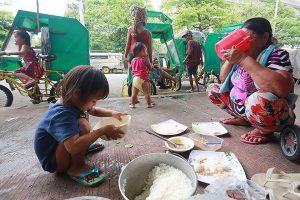By Kyle Aristophere T. Atienza, Reporter
THE PHILIPPINES needs new health taxes to fund nutrition programs amid spiraling prices that have worsened malnutrition, which is likely experienced by near-poor households, according to an economist.
“New resources are needed to subsidize the nutritional requirements of the poor,” Filomeno S. Sta. Ana III, coordinator at advocacy group Action for Economic Reforms, said in an e-mail. A tax on sweetened beverages could be earmarked for nutrition programs, he added.
“The first win is that such health taxes discourage the consumption of unhealthy or harmful products such as tobacco, alcohol and sweetened beverages,” he said. “The second win is that the revenues from these taxes are earmarked for health and nutrition.”
A “catastrophic event” in the family or a nationwide shock could affect them and make them absolutely poor, Mr. Sta. Ana said.
“The problem of stunting and wasting arising from undernutrition is not limited to the extreme poor households but also includes the near poor,” he added, citing opinion polls and government data.
A recent Social Weather Stations (SWS) poll showed that 16 million or over 50% of Filipino families labeled themselves poor, the highest in more than two decades.
This could get worse amid recent “nationwide shocks,” the group said.
The National Economic and Development Authority (NEDA) has been under fire for its poverty metrics, which considers Filipinos not “food poor” if they have a budget of a little over P20 for each of their three daily meals.
As of 2023, the monthly food threshold for a family of five was P9,581, or about P64 per person a day,” NEDA Secretary Arsenio M. Balisacan told lawmakers last month. He said the food-poor threshold in 2021 was P55 and P63 last year.
Data from the Philippine Statistics Authority (PSA), whose board is led by the NEDA Secretary, showed that a family of five people needed at least P 13,873 monthly to meet their minimum basic food and nonfood needs last year.
Nine regions in the country had poverty thresholds higher than the national average, it said, with Central Luzon leading the list with a P16,046 poverty threshold. It was followed by Metro Manila with P15,713, and Calabarzon with P 15,457.
Soccsksargen posted the lowest poverty threshold or P12,241.
While the PSA data showed that the number of people living in poverty fell to 17.54 million from almost 20 million people in 2021, 2.7% or about 740,000 families did not have enough income to meet their basic food needs.
Mr. Sta. Ana said those who are just above the government’s poverty line would naturally and “expectedly describe themselves as poor” due to economic uncertainties.
“A catastrophic event in the family or a nationwide shock will greatly affect them and make them absolutely poor.”
The SWS self-rated poverty pool, which Mr. Sta. Ana said captures the sentiment of people, rose to 58% in June from 46% in March, the highest since June 2008 at 49%. Hunger rose to 17.6% from 14.2%.
The Philippines has been counting the costs of recent natural calamities including Severe Tropical Storm Yagi (Enteng), which killed more than a dozen people and affected more than 700,000 families in 10 regions.
The storm caused more than P600 million in farm damage and over P698 million in infrastructure damage.
Jefferson A. Arapoc, who teaches economics at the University of the Philippines Los Baños, said the food bundle developed by the Food and Nutrition Research Institute, which serves as a basis for NEDA’s food metrics, must be re-examined.
This is because it may not cover people engaged in physically demanding jobs and may not be responsive to state efforts to boost the country’s demographic dividend advantages.
“It’s clear that while a 2,000-calorie diet may meet the average needs of most adults, caloric requirements can vary significantly based on factors such as age, gender, weight, height and activity level,” he said in an e-mail.
“For instance, individuals engaged in physically demanding jobs — often those from lower-income backgrounds working in roles like janitorial services or construction — require a higher caloric intake to sustain their energy levels,” he added. “Additionally, simply listing foods that meet daily caloric needs is overly simplistic.”
MORE REALISTIC METRICS
Mr. Arapoc said the government’s food-poverty metrics “overlooks both the direct and indirect costs associated with acquiring, preparing and consuming these foods.”
“If we truly want to maximize the benefits from demographic dividends, we must prioritize the health of our workforce, ensuring they are fully capable of contributing their maximum potential.”
He noted that nutrition issues such as child stunting and wasting have irreversible consequences for the future workforce, “limiting their ability to contribute effectively to the economy.”
“If we neglect this issue now, we risk undermining the long-term potential of our labor force. It is crucial that we address this issue to ensure the future productivity of our workforce.”
Mr. Sta. Ana said subsidies under the government’s flagship poverty alleviation program Pantawid Pamilyang Pilipino Program (4Ps) must be increased amid high inflation.
The amount also does not cover the nutritional needs of pregnant mothers and children in their first 1,000 days, he added.
Philippine inflation eased to 3.3% last month from 4.4% in July, after a moderate rise in food prices and a decline in transport costs.
Nonalcoholic beverage prices fell by 3.9%, while transport prices declined by 0.2%.
Rice inflation, which has been a major headache for the government in recent months, slowed to 14.7% from 20.9% in July and 22.5% in June. Still, it remained the top contributor to last month’s inflation, which was within the Philippine central bank’s 2%-4% target.
“The inadequate social services, particularly healthcare, make the situation all the more distressing for the population,” Mr. Sta. Ana said.
“Out-of-pocket expenses for health are equivalent to 46% of total current health expenditure,” he added.
The previous trend of decreasing out-of-pocket expenses as a percentage of health expenditures has been reversed, he said, citing World Bank figures.
Meanwhile, Mr. Arapoc said a more realistic poverty metrics is crucial to effective policymaking. “Evidence-based interventions can only be successful if the underlying metrics accurately reflects the problem at hand,” he added.
The Philippines aims to reduce poverty by 8.8%-9% by 2028, but a De La Salle School of Economics report in June said the target could only be met by 2035.
“If policies are based on flawed or inadequate measures, they may fail to address the core issues, potentially exacerbating the very problems they aim to solve,” Mr. Arapoc said. “This could lead to policies that achieve superficial success but fail to address the actual problem.”

